If you click a picture it will be enlarged. The pictures can then be viewed in succession as a SLIDESHOW. If you see a link, for example: Namasté; click on the link and it will be opened. When referring to a map, the map can be accessed by clicking on the link : map of Bali. The clips (images with an arrow) that are included are HD recordings. The clips can be viewed in a separate window that automatically opens when you click on the image with the arrow.
English is not our native language, so we apologize in advance for translation- spelling- and grammar errors.
We have an early start today: 6.15 am breakfast and around 7 am departure to the airport. It is only a short drive to the airport. The section of the airport for domestic flights is fairly quiet. It looks modern. We have some delay and a gate change but eventually we find our way. We walk over the airfield to the airplane while the airport cars pass us left and right with high speed.
The stairs to the plane has 5 steps ... We love small aircrafts! Just 2 to 2 side-by-side seating in a row. The plane is only for 1/3 filled. We take a seat behind each other; each at a window.
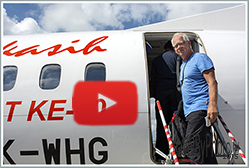
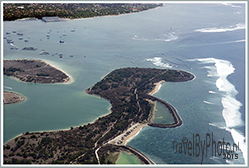
It is beautiful to fly over the Islands. We fly low. You can clearly see the surf at the coast. Somtimes there is secound row of breakers a 100 metres from the coast. Beautiful beaches. We have a safe flight. On Sumba we land in Waingapu (map of Sumba).
Waingapu is the administrative capital of the Eastern Sumba registry and has an estimated 10,000 inhabitants. The city is the largest of the island
What a cute little airport. They still transport the luggage of the plane to the luggage belt with a trolley pulled by hand. And at the airport there is only one baggage claim! Nice!
Our guide and driver Johannes is already waiting for us. Perfect planning. Nice man. In the barely 10-minutes it takes to drive to the hotel he has already given us a load of information. He tells the story of his grandfather who had gone to the Netherlands just before the secound worldwar in connection with a conflict in views on the doctrines of the faith between 2 Dutch pastors on Sumba. Because of the outbrake of the war he could not get back to Sumba in time. Therefore he had to stay in Netherlands for 7 years before he could return. The guide tells enthousiatic about the mission and the protestant church. Jan-Arend accidentally says that he is the son of a Calvinist Pastor. Jofhannes is excited. The result is that he thinks we are very interested in visiting every church on the Island ... well, actually we are not.
Our hotel in Waingapu, hotel Tanto, is downright boring! One piece of concrete. Bit of a downer after our stay in cozy Sanur. Our room is not yet availeble as we arrive in the hotel. For us no problem but Johannes is very angry. The hotel is very tasteless decorated. Nowhere a photo or painting. No garden with some flowers. Nothing, only concrete walls and paving stones. So we are not going to wait in the hotel for our room to get ready, but leave as fast as possible for a walk to the village.
The village is not very special too but we find a good restaurant where we order nasi. Very tastefull. Then back to the hotel for some rest. In de evening we have diner in the hotel. Good food. They don't serve alcohol in the Hotel. Very useful for our wallet. Diner in the Hotel costs about 6 euros 50 (nasi, rice noodles and 2 bottles of water).
As we leave the restaurant and enter our hotelroom , we spot a large cockroach rushing through the room. Brrrr. Ingrid does not fancy the critters, but Jan-Arend has learned on a previous trip to Curaçao: no panic, no crushing or other forms of violence. Just keep patience. Catch and lock the cockroach under a glass and leave it there. The problem will resolves itself. The beast can't escape and the hotelstaf will clean up the next morning.
We have slept fine. It may not be a romantic hotel, but the beds are excellent as well as the shower/bathroom! The breakfast is not a great success. We were the only ones in the restaurant where we had dinner yesterday. 5 personnel members were busy ... with themselves. Only after 10 minutes someone comes to us and asks what we want. Eh.. have breakfast ...? Impossible!. After long joint consultation we are directed to another building.
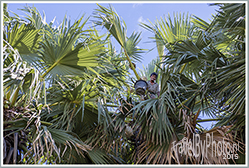
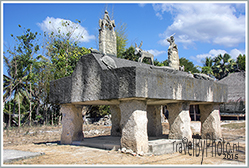
What is the case? There is an annex buillding far away from the restaurant. In a large room are the drivers. We may join them. No one had told us that when we arrived. Well, perhaps it is because they know themselves that they serve a lousy breakfast. Haha.
Today we explore eastern Sumba. Our first stop is at a small plantation where we see a number of farmers climbing in the top of palm trees collecting a sweet juice by making a cut in young shoots high up in the palmtree. After the cut is made the juice guts out right away of the tree and gets collected in a basket. Incredible how the men climb without any tool to the top of the tree and, once at the top, move from one tree to another, They are really very capable in tree climbing
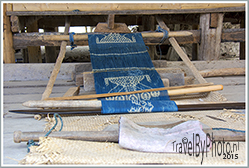
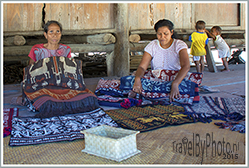
From the juice palm sugar is made. From the sugar they made us a plate fondante. Very tasty!
We visit a few villages like the traditional villages of Pau and Rende (map Sumba) with their houses with high hat-shaped roofs. Everywhere in the village you see people weaving, especially cloths with ikat motifs. The locals make the most beautiful canvases and of course everyone wants to sell their canvas to earn some money. The merchendise is (rightly so) expensive: It takes a lot of time and handwork to make the ikats. We don't buy. We don't really have a good spot at home to exhibit such a beautiful art object the proper way. A pitty!
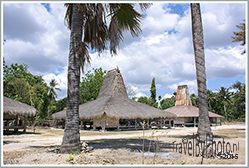
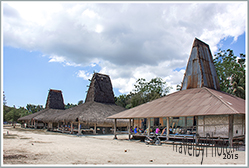
The grave villages here on Sumba are known for their table-shaped stone graves with special engravings and images. There are tombs of Kings, with a crocodile on it often with a stone in front of the monument that covers the body of his servant. The servant is buried concurrent with the funeral of the king; even if he did not die naturally.
The villages are still managed by the local Raja, a kind of King. Officially this raja does not have any political power, but the local population still consider him as their leader.
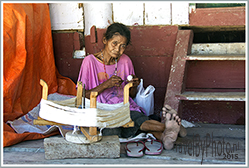
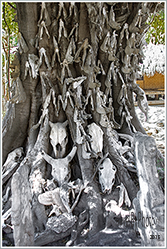
Some houses have walls of buffalo skin. Under the roof of the houses, baskets of betel nuts are stored for the ancestors. Ikat cloths hang on bamboo sticks and racks on the porch to dry after a batik dye bath . Especially the white and blue motifs are very attractive.
Beautiful trees here, with lots of aerial roots along the trunk. Everywhere Wild pigs who are sleeping in the shade. Outside many bougainville in many beautiful colors.
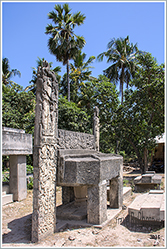
After our visit to Pau and Rende we drive to a place where salt is extracted from clay! Wet clay is put into funnel-shaped baskets. The water that drips out is caught and heated so that it evaporates. What remains is the salt. Hard work in the bright sun! There is only a little cabin with a canopy that offers some protection.
In yet another village we spot a tree that from root to crown is decorated with skeleton parts. A very special form to exhibit your trophies.
In each village that we visit we have to sign the guestbook and make a donation of some 20,000 rupees (about 1.30 euros). We don't mind. It is a fair system. We get the opportunity to visit the village and the money goes to the whole community itself and everything is listed. When we return in Waingapu we visit the port. There is not many activity in the harbour. Only a few boats. But there is a delicious breeze blowing! Very refreshing!
Back at the hotel, a lady of the hotel hands over to us a printed email. The local airline where we have booked a flight from Sumba to Flores (our next destination) has cancelled our flight. A beachday on Sumba is now converted into an extra travel day with a flight to Timor! From Timor we travel the next day to Flores. Bad luck one day sitting at the beach has become a day sitting in an airplane, but we understand why the flight is canceled. On our flight to Sumba were hardly any passengers.
Today we check out of our hotel in Waingapu. In the car park in front of our roomdoor the drivers are waiting for their passengers. A couple of drivers lean smoking against our door. When we open the door they almost fall into our room. Oeps sorry. The room inventory is accurately checked before we may leave. All items in the room are listed on a large sheet in the room with the price for replacement when something is missing or damaged. Everything is being found in order. It is a new hotel; hospitality is not yet their quality mark.
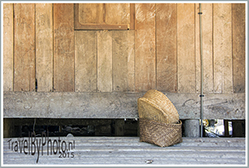
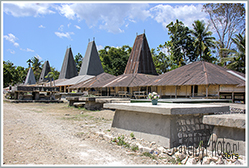
Today we drive to Marosi on West Sumba. (map of Sumba). Sumba has a hilly landscape with a Savannah-like nature with low shrubbery and sometimes a piece of forest area. When driving to Marosi we make several stops. We visit the traditional villages Pasunga and Waibakul. There are old tombs. The villages seem extincted. The high characteristic point roofs are here mostly of sink plates.
The island is beautiful but there are also many arid pieces. It has to do with the season we are here too of course. It is the end of the dry season. Here and there is water that can be used for irrigation. The fields there colours fresh green. We see many different trees en route. Mahogany trees and trees with betel nut and macademia nuts for example.
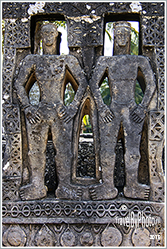
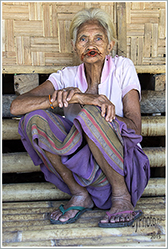
The traditional houses are originally covered with a special grass (alang-alang). The new build houses in the villages are now mostly made of stone. This part of Sumba is famous for its horses. You can see a striking number of them in the pastures! A few times a year this region is the stage for famous horse racings (Pasola). The Pasola should be a big event and huge feast!
We visit a small local weekly market on the side of the road. Market vendors with small servings tomatoes, dried fish and betel nuts in front of them. The houses are often decorated with rows of jaw bones of among other pigs and oxen.
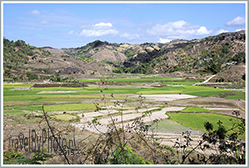
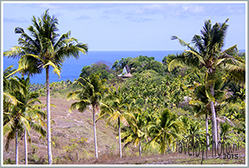
Then, when we are close to the hotel, we can see the sea. Our hotel Sumba Nautil Resort looks great. All atmosphere that the Tanto hotel failed is is here more than present.There are 7 small cottages, with a spacious outdoor terrace with a sofa and a beautiful view of the sea..
The cottage itself is also spacious and attractively furnished. Beds with fresh flowers on top as welcom sign, comfortable chairs and there is a swimming pool where we take a nice dip. The food here is on a fixed time. You can choice between 2 menus. The food is reasonable; a little bland for our taste. But the ambiance is unique. Covered tables with a candle on a terrace overlooking the sea.
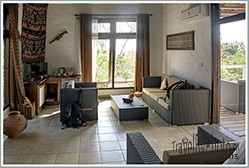
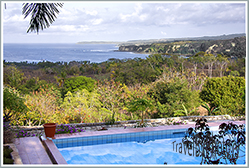
At our cottage there are some geckos that occasionally make themselves loudly heard. We think it's a nice sound!
Our guide tells us the hotel is run by a Moroccan man. The hotel is actually owned by his first wife; a French woman. They are now separated. The lady has returned to France. He stayed on Sumba with 2 Sumbanese women and a bunch of children and manages the hotel. His French ex still regularly visits the hotel together with her 30 years younger toyboy. We laugh over the juicy story, but our guide is confounded!
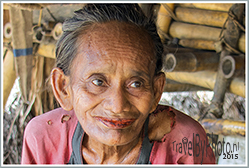
Delicious breakfast! A still warm freshly baked bread roll, toast, jam, fruit and an egg mmmm. A very A very pleasant start to the day.
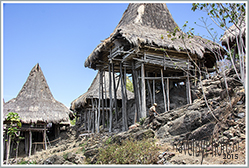
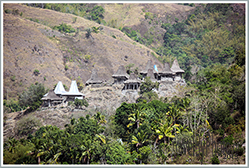
There is a misunderstanding about our pickup time. Therfore we have to wait for a while, but soedah! We go on road to visit a village. We penetrate deeper and deeper by on the island. The roads become small and narrow. Beautiful scenic views. We are also getting a better vieuw of the ordinary daily life here. Cows, water buffaloes, chickens and goats everywhere. Many different trees that are all special to us.
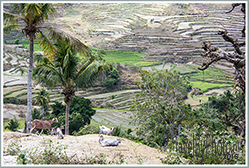
We cross the Kadengar River by car. That would be impossible in the rainy season! We are heading for Sodan ( map of Sumba). The village is located high on a Hill on the other side of river. We can't get to the village by car. So we have to walk. Not so easy. It is a steep climb and it is very hot. After losing the necessary drops of sweat we arrive in the village.
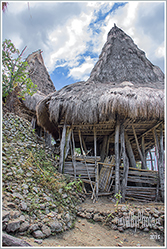
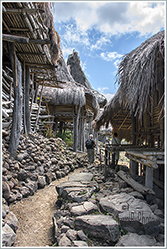
We have to visit the priest in his hut at the entrence of the village first before we are allowed to enter the village itself. We sign the large guestbook and hand over the priest the betel nuts that we have bought in advance specially for this occasion.
A visit to Sodan is well worth the climb. What a nice authentic village. The traditional houses are on high stilts. Here everything is still originally (with the exception of some small solar panels; clever! and durable!). All houses have roofs made of grass. All pointed roofs like hats. Below the roof it is pleasantly cool in the hut and on the verandah!
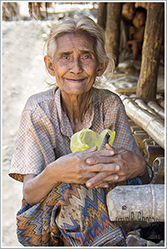
We see women with buckets on their heads. They climb the hills with ease on bare feet while we on our hiking boots had to struggle to stay on your feet when we climbed to the village!
Really a idyllic village! According to the big book, they receive tourists 1 or 2 times a weeks. Villagers are busy with leaves, and a woman stomps in a wooden mortar bowl a kind of grain. In the middle of this village the tombs of the ancestors.
A woman is weaving a rug on one of the waranda's. We present some kretek cigarettes to the villagers. The kretek cigarettes are definitely wanted! Moreover, the priest had immediately confiscated the first full cigarette package even before we have entered the village. Many young dogs, chickens and a potbellied pig.
After our visit we walk back to the car. Marosi is known for its beautiful beaches. We would love to take a cool dip in the sea. We ask the guide to bring us to a nice beach. He understands what we mean. When we arrive we turn out to be the only ones on the beach. We swim and sit in the sun and the shade. That doesn't happen often; a beach only for ourselves!
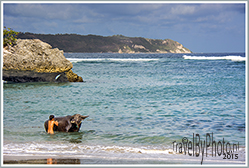
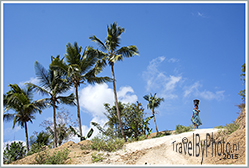
After a while a few little boys come to play on the beach. They are trying to sell us coconuts but we don't buy. A bit later, a father with son enters the beach. They are comming to the beach to clean their Buffalo in the sea. So special to behold everything happening on the beach, to swim, play in the waves and relax doing some reading while listening music.
In the evening we have diner in the hotel. There is a 3 course menu that is identical to yesterdays menu. No suprice there. But okay there is no other restaurant in the neighborhood and the food is of course of good quality.
This morning we leave for a visit to Tarung.
Some of the most beautiful megalithic tombs of West Sumba are situated in Tarung (map of Sumba). Tarung is a village on a hill west of the Centre of Waikabubak. ( mao of Sumba). It is a nice village, with thatched/alang-alang roofs on the houses.
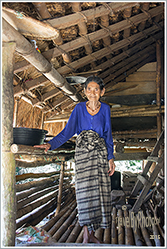
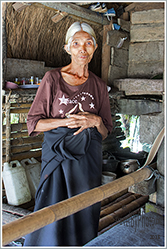
Tarung is the highest hamlet in a complex of three small kampongs with a total of 33 houses. The houses on the lower slopes have modern roofs topped with sink plates, but each of the nine most important houses of Tarung have traditional alang-alang roofs. These houses are placed around the tombs. Tarung is one of the most spiritual centers of the island
At the end of the village a "new" house is being built. A skeleton of concrete and a roof of corrugated iron. Well quite understandable of course these changes in building construction. We make our homes more and more luxurious as well and corrugated sheets are more durable and are much less flammable. In the rainy season the clatter of the rain on the roofs makes a huge noise. It's atractive village.
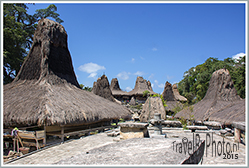
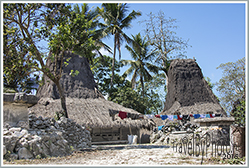
Everyone in the village wants to sell something. We buy a beautiful rag of an old woman.
ots of horns and jaw bones attached to the houses again. We are invited in one of the houses. After our visit we see another market. We look around. Coloured fruits and vegetables. Local day markets are always interesting to visit. No matter what country you are in. Nice!
After our visit to the market we drive to the Sumba Barat National Park. A park that is not much visited by tourists. The ride to the park is beautiful. We drive through a historic nature forest.
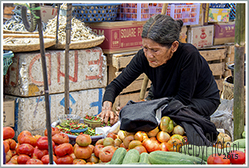
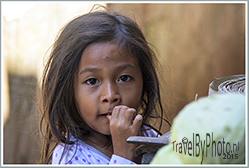
During the last stage of our ride we descend . We park the car and hike on narrow paths and bamboo bridges to a waterfall. A beautiful walk. A few local people are swimming in the pool in front of the waterfall.
We walk back to the car and drive away again. A nice trip along all sorts of different villages.
Eateries are rare in this area but our guide knows to find us a homerestaurant at the sea where they can prepare noodles for us. It's a beautiful quiet spot in the shade with dogs and piglets sniffing around us and colorful fishing boats on the beach in sight. Lunch is also quite tasty! After lunch it is time for us to leave again from this lovely spot.
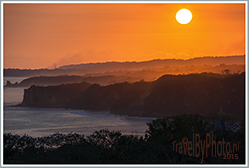
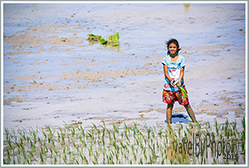
With a detour we drive to the hotel. At several places beside the road we see farm workers work in the rice fields. In a row next to each other the farm workers stitch the rice cuttings in the wet ground.
Back in the hotel we still have some time left to relax, to read and swim. We witness a beautiful sunset!
The last day already with our Sumba guide and driver. We leave early; 7 am. Too early for breakfast. That is why breakfast is Packed to take with us. Tasty fresh bread with omelet.
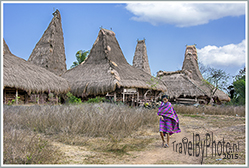
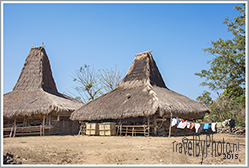
Today we will drive to Tambolaka ( map of Sumba). It will be a long ride. We drive through the Kodi district, famous for the houses with the highest peak roofs of Sumba. The surroundings are idyllic with wide sandy beaches and the blue sea. We get a very good impression of the island. Many homes still have traditional roofs. En route we will visit two particular villages
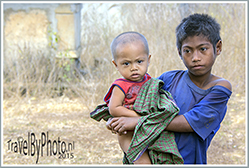
First we visit Paronabaroro village. Only traditional houses. We fill in the guest book and pay the 20,000 rupees "donation". Many children swarming around us. Most villagers are bivaking on their porches in front of their house. The houses are very spacious inside. In the high roof is enough space for the spirits of the ancestors. There are ancient tomb remains of up to 1000 years ago.
The people are friendly. The children look less cared for here. Wounds and so on. Normely about 60 people live in the village but once a year a big party is held here. Family comes from everywhere to join the party. The village accommodates over1000 people during the feast and a couple of hundred buffalo are being slaughtered! A real busy and big event!
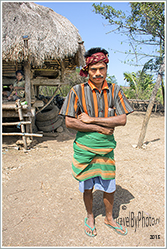
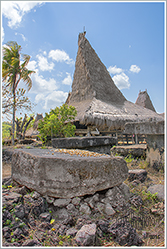
Then on to the next village; Wainyapu village. This village is situated beautifully by the sea. In the distance you see old tombs on a kind of Peninsula in the sea. It is quieter here. Truly beautiful houses and a very nice panorama. The kids play with homemade toys. A boy runs behind a rolling old tire. He keeps the tire rolling with a stick when it threatens to fall. We buy some homemade carved wood pieces and canisters of hollowed leg with a wooden seal; the people are not rich.
15 years ago this village was totally destroyed by a big fire. Now it is completely rebuilt. It is very nice here with the large white, quiet beach at the background.
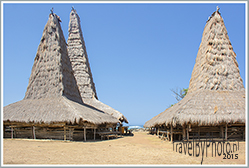
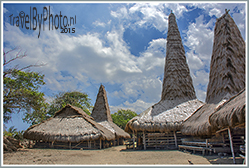 On our way back we make one more stop at a daymarket we come across. The people watch at us with big eyes. They have clearly not yet seen many foreigners here. There are chickens, betel nut, vegetable stalls; all kind of merchandise is exhibited on the market. We also see a large puddle at a river. The people are swimming, washing themselves and paddle on a raft of bamboo in the puddle..
On our way back we make one more stop at a daymarket we come across. The people watch at us with big eyes. They have clearly not yet seen many foreigners here. There are chickens, betel nut, vegetable stalls; all kind of merchandise is exhibited on the market. We also see a large puddle at a river. The people are swimming, washing themselves and paddle on a raft of bamboo in the puddle..
It's Sunday today. Church services are held everywhere. People are dressed up at their best. The girls wear beautiful dresses. The churches somtimes are too small for the crowd. A lot of people then participate the service on plastic chairs outdoor the church.
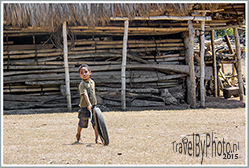
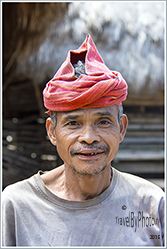
The road that runs along the Church is even closed during the time of the service, whereby we have to drive a bypass around the church to follow our ride to our next hotel. Special to see how much more religion (protestant) here is present in daily life compared to the Netherlands!
We arrive in our hotel; Newa Sumba Resort . at around 1 pm. The name of the hotel sounds like a luxerious water-sports centre, but nothing could be further from the truth! It's very simple. The room is located in a traditional Sumbanees cottage. Everything is a bit dated but still functions fine. On the porch is even a refrigerator and there is air conditioning. We are the only guests! We eat a snack in the restaurant where we, of course, are the only ones too. A simple but nutritious Indonesian meal. It is very colorful here! Flowering bougainvillea everywhere in many different colors.
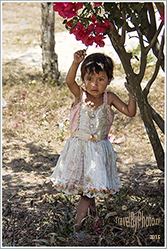
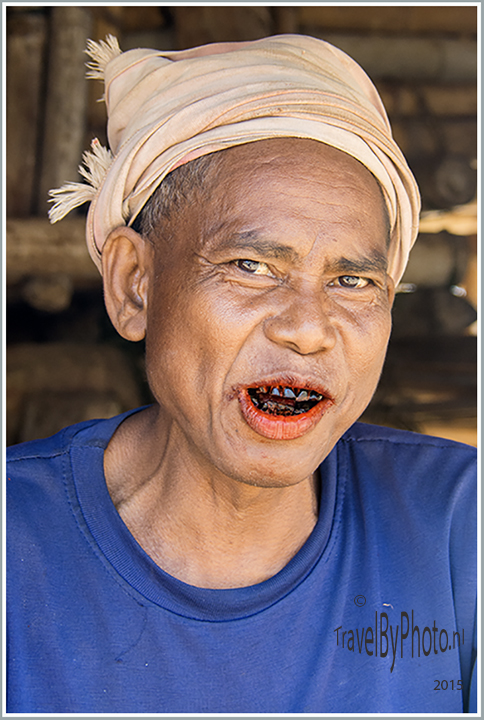
The hotel is located directly on a beautiful white beach. We hurry to get there. We enjoy a dip in the delicious seawater and relax in the shade of a tree with some reading and listening to music. It's fabulous here.
In the evening we have dinner in the restaurant. How different here then anywhere else. We are the only ones on a big romantic porch. The food is served by 2 men who are waiting patiently outside the kitchen till the food is ready. They ask us if it's okay that they deliver breakfast tomorrow directly to our room.
Jeh, that is really a good plan.
We get, as agreed, our breakfast on the porch in front of our room. Simple but good. We have all morning before we will be picked up for our flight to Timor. The airport is not far. Therefore, we still have enough time to go to the beach again after breakfast. Just some walking on the beach and some swimming though that's not only easy because it's low tide and the sea remains very long shallow.
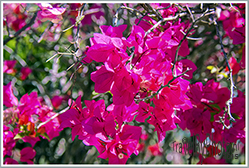
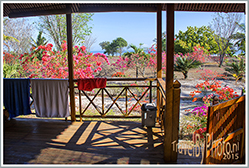
Fortunately, we have water shoes. So unique; only we two on the beach. We would be picked up at 12 noon, but the taxi is already there at 11.30 a.m. Half an hour later we are dropped at the airport, that's pretty early since the plane leaves at 2.30 p.m. It is a very small airport. We wait patiently and enjoy a cold drink in a cool place in the open air.
We fly Garuda today. A bigger plane, but still rows of 2 to 2 side-by-side seatingIt is a comfortable flight; We even get a snack and a drink served.
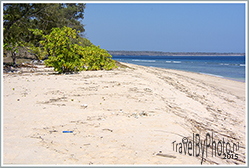
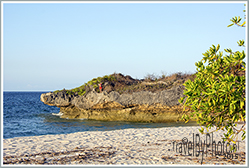
At 4 pm we land in Kuteng on Timor. Someone from the hotel is waiting for us, but it still takes quite a long time before transport arrives. The car seemed to have bad luck.
So now we check in at the "on the Rock hotel" in Kuteng. We have a typical standard hotel room. Fine and complete with coffee/tea making facilities but also very impersonal. There is a large swimming pool. Unfortunately we will not see much of Timor. It is an unforeseen slopover and we will leave the next day again at time. Regrettable because Timor seems to be very beautiful too.
Because it's already 5.15 pm as we arrive at the hotel we stay at the hotel. No punishment. Direct sea view with a lovely terrace outside. Among us the pool, immediately behind the sea. We have a cold beer, a glass of wine and some snacks and they have wifi so we can contact the home front. All ok there .
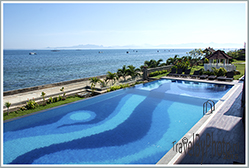
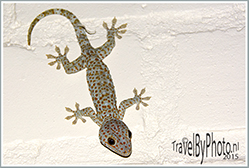
In the evening we have a nice Indonesian diner. Very cheap by the way!
Next stop: Floris